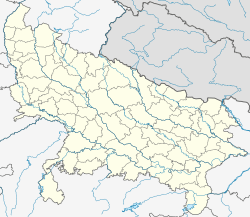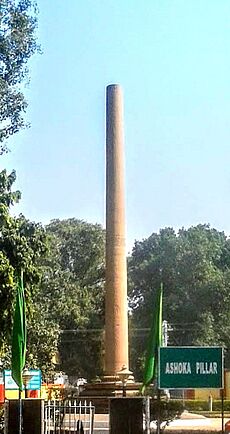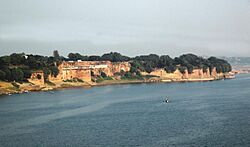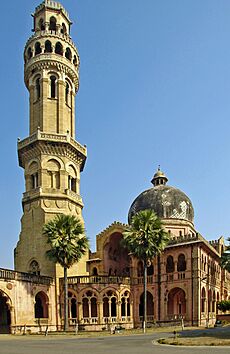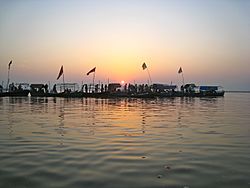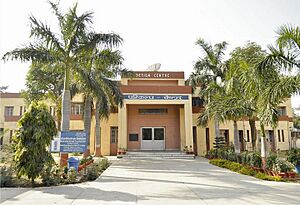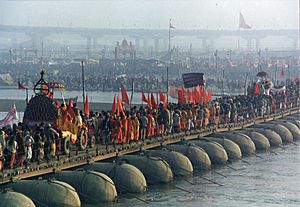Prayagraj facts for kids
Quick facts for kids
Prayagraj
Allahabad
|
|
|---|---|
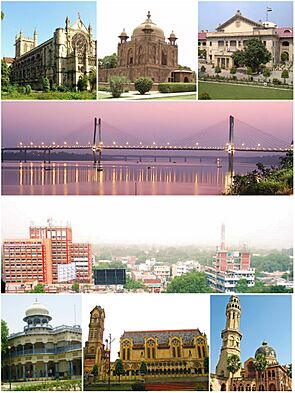
Clockwise from top left: All Saints Cathedral, Khusro Bagh, the Allahabad High Court, the New Yamuna Bridge near Sangam, the skyline of Civil Lines, the University of Allahabad, Thornhill Mayne Memorial at Chandrashekhar Azad Park and Anand Bhavan
|
|
| Etymology: King of the Prayagas | |
| Nicknames:
The Sangam City and City of Prime Ministers
|
|
| Country | |
| State | Uttar Pradesh |
| Division | Prayagraj |
| District | Prayagraj |
| Earliest mention | c. 1200–1000 BCE |
| Established as Ilahabas | 1584 |
| Established as a city | 1801 |
| Named for | Panch Prayag |
| Government | |
| • Type | Municipal Corporation |
| • Body | Prayagraj Municipal Corporation |
| Area | |
| • Total | 365 km2 (140.9 sq mi) |
| Area rank | 10 |
| Elevation | 98 m (321.52 ft) |
| Population
(2020-2011 hybrid)
|
|
| • Total | 1,536,218 |
| • Rank | 7th in Uttar Pradesh 36th in India |
| • Density | 4,209/km2 (10,903/sq mi) |
| • Metro rank | 40th |
| Demonyms | Allahabadi Ilahabadi |
| Language | |
| • Official | Hindi |
| • Additional official | Urdu |
| • Regional | Awadhi |
| Time zone | UTC+5:30 (IST) |
| PIN |
211001–211018
|
| Telephone code | +91-532 |
| Vehicle registration | UP-70 |
| Sex ratio | 852 ♀/1000♂ |
Prayagraj (also known as Allahabad) is a big city in the Indian state of Uttar Pradesh. It's the main city of the Prayagraj district, which is the most populated district in the state. Prayagraj is also the judicial capital of Uttar Pradesh, meaning it's where the highest court in the state, the Allahabad High Court, is located.
As of 2011, Prayagraj was the seventh most populated city in Uttar Pradesh and the thirty-sixth most populated city in India, with about 1.53 million people. It was even ranked as the world's 40th fastest-growing city in 2011. Hindi is the most spoken language here.
Prayagraj is very close to Triveni Sangam, which means "three-river meeting point." This is where the Ganges, Yamuna, and the mythical Sarasvati rivers are believed to meet. This spot is very important in Hindu scriptures. The city is mentioned in ancient Hindu writings as one of the oldest known cities in the world. It was once called Prayāga, a holy city.
The city was also known as Kosambi in ancient times, named by the Kuru rulers. Kosambi was a major city in India for a long time. Since then, Prayagraj has been an important center for politics, culture, and administration in the Doab region.
The Mughal emperor Akbar founded a great city in this area. It was called Ilahabas or Ilahabad. Later, in 1858, Allahabad became the capital of the North-Western Provinces and was even the capital of India for one day! It played a big role in the struggle for India's freedom.
Prayagraj is a popular place for tourism, coming in second for tourist visits in Uttar Pradesh after Varanasi. The city covers about 365 square kilometers. It has many colleges, research centers, and government offices. Prayagraj also hosts big cultural and sporting events, like the Prayag Kumbh Mela and the Indira Marathon. While tourism was once its main income, now much of its money comes from real estate and financial services.
Contents
What's in a Name? Prayagraj's Meaning
The name Prayagraj comes from Prayāga, which means "place of a sacrifice" in an ancient language called Sanskrit. People believed that the god Brahma performed the very first sacrifice here.
The word prayāga also means "where rivers meet." For this city, it refers to the meeting point of the Ganges and Yamuna rivers. An old story says that a third, invisible river, Sarasvati, also joins them there. Today, this meeting point is often called Triveni Sangam (or just Sangam).
The name Prayagraj (Sanskrit: Prayāgarāja) means "the king among the five prayāgas." This shows how much people respect this meeting point as the most amazing of the five sacred river meetings in India.
The Mughal emperor Akbar visited this area in 1575. He was so impressed by its location that he ordered a fort to be built. The fort was finished by 1584 and was named Ilahabas, meaning "Abode of Allah." This name later changed to Allahabad under Shah Jahan.
Over the years, there were attempts to change the name back to Prayagraj. Finally, in October 2018, the government officially changed the city's name to Prayagraj.
A Journey Through Time: Prayagraj's History
Prayagraj has a very long and interesting history!
Ancient Times: A Holy City's Beginnings
The earliest mentions of Prayāga and its holy journeys are found in ancient Hindu texts from around 1200–1000 BCE. Even the Pali texts of Buddhism from about 500 BCE mention Payaga (Prayaga). The great epic Mahabharata (around 400 BCE–300 CE) talks about bathing at Prayag to make up for past mistakes.
Ancient Hindu texts also describe Prayag as a busy place with pilgrims, priests, and vendors. It's also mentioned in the Hindu epic Ramayana as the home of the wise sage Bharadwaj.
Digging Up the Past: Archaeology and Inscriptions
Archaeological digs have found ancient pottery from 600–700 BCE, showing that people lived here a very long time ago. The famous Ashoka Pillar in Prayagraj has writings from the 3rd century BCE. It also has an inscription from Birbal (from Akbar's time) that mentions the "Magh mela at Prayag Tirth Raj" around 1575 CE.
Many experts believe this pillar has always been at its current spot, right where the rivers meet. Smaller writings on the pillar, some dating between 1319 CE and 1575 CE, often mention the month of Magha. This suggests they are linked to the Magh Mela pilgrimage, a bathing festival.
Early Medieval Period: Travelers' Tales
In the 7th century, a Chinese Buddhist traveler named Xuanzang (Hiuen Tsang) visited Prayaga. He described it as a "great city" where the Yamuna and Ganges rivers meet. He noted many temples and Buddhist places. He also saw Hindu bathing rituals at the river junction, where people believed bathing would wash away their sins. Rich people and kings would come to give gifts to the poor.
Before the Mughal emperor Akbar, historical writings mostly used the name Prayag. It seems that over time, the river changed its path, and the meeting point shifted to where Akbar later built his fort.
Mughal Rule: Building a New City
Records from the time of Akbar say that he wanted to build a great city where the Ganges and Yamuna rivers meet. In 1583, he started building the city and four forts. He named it Ilahabas, which later became Allahabad. Akbar was impressed by how good the location was for a fort. It helped him control the fertile Doab region and showed his power to the many non-Muslims who came there for pilgrimages.
Later, Akbar made Ilahabas the capital of one of his twelve regions. Some say the name was changed to Ilahabad by Shah Jahan because the "-bas" ending sounded too Hindu. This led to the two spellings: Ilahabad and Allahabad.

After Akbar, his son Jahangir (then Prince Salim) took control of Allahabad for a while. Later, during a war for power among Mughal princes, the fort was given to Aurangzeb's officers in 1659.
British Rule: A Center for Independence

The British East India Company wanted the fort because of its important location. British troops first came to Allahabad fort in 1765. After some battles, the fort and surrounding areas were given to the British.
Allahabad was part of the 1857 Indian Mutiny. After the rebellion, the British made Allahabad an important administrative center. They set up a high court and police headquarters here. In 1858, Earl Canning announced Queen Victoria's proclamation in Minto Park, which transferred control of India from the East India Company to the British Crown. Allahabad was the capital of the United Provinces from 1902 to 1920.
The city became a center for the Indian independence movement. In 1931, Chandrashekhar Azad died in Alfred Park while surrounded by British police. The Nehru family homes, Anand Bhavan and Swaraj Bhavan, were important places for the Indian National Congress. Many freedom fighters like Purushottam Das Tandon and Narayan Dutt Tiwari lived here.
Prayagraj's Location and Environment
City Layout: Old and New Areas
Prayagraj is about 90 meters (295 feet) above sea level. The older part of the city, south of the railway station, has neighborhoods like Chowk and Johnstongunj. North of the railway station is the newer part, built during the British rule, with areas like Civil Lines and Georgetown.
Civil Lines is the main business area. It's known for its planned streets and tall buildings. Many buildings in Prayagraj show a mix of Indian and Islamic styles. Famous landmarks include the Allahabad Museum, New Yamuna Bridge, and Allahabad University.
The Holy Meeting Point: Triveni Sangam
The Triveni Sangam is where the Ganges, Yamuna, and the mythical Saraswati rivers meet. It's a very important religious place and the site of the famous Prayag Kumbh Mela, held every 12 years. It's also where the ashes of many national leaders, including Mahatma Gandhi, have been scattered.
The main bathing spot (ghat) in Prayagraj is Saraswati Ghat on the Yamuna river. You can also take a boat from here to reach the Triveni Sangam.
Where is Prayagraj?
Prayagraj is in the southern part of Uttar Pradesh, right where the Ganges and Yamuna rivers meet. To its southwest is Bundelkhand, and to the east is Baghelkhand. The city is divided by a railway line. Prayagraj is culturally important as the end point of India's west.
Weather in Prayagraj
Prayagraj has a humid subtropical climate. This means it has three main seasons:
- A hot, dry summer (March to May) where temperatures can reach 48°C.
- A hot, humid monsoon season (June to September) with lots of rain.
- A cool, dry winter (December to February) where temperatures rarely drop to freezing.
The city gets most of its rain from June to September. Prayagraj never gets snow, but it can have thick fog in winter.
Amazing Animals and Plants: Biodiversity

Prayagraj is in a region known for its unique plants and animals. Sadly, many animals have disappeared, and others are in danger. The Allahabad Museum is working to record the plants and animals of the Ganges and Yamuna rivers.
To protect the animals in the Ganges river, a Turtle sanctuary and a River Biodiversity Park are being built near the Sangam.
Common birds in the city include doves, peacocks, house sparrows, and parakeets. You can find many deer in the area across the Yamuna river. India's first special area to protect blackbucks is being created in Prayagraj's Meja Forest Division. Other animals include lizards, cobras, and gharials. In winter, many Siberian birds visit the Sangam and nearby wetlands.
People and Population
| Population growth of Prayagraj Municipal Corporation | ||
|---|---|---|
| Year | Pop. | ±% |
| 1820 | 20,000 | — |
| 1865 | 105,900 | +429.5% |
| 1871 | 143,700 | +35.7% |
| 1881 | 148,500 | +3.3% |
| 1891 | 175,200 | +18.0% |
| 1901 | 172,032 | −1.8% |
| 1911 | 171,697 | −0.2% |
| 1921 | 157,220 | −8.4% |
| 1931 | 173,895 | +10.6% |
| 1941 | 246,226 | +41.6% |
| 1951 | 312,259 | +26.8% |
| 1961 | 411,955 | +31.9% |
| 1971 | 490,622 | +19.1% |
| 1981 | 616,051 | +25.6% |
| 1991 | 792,858 | +28.7% |
| 2001 | 975,393 | +23.0% |
| 2011 | 1,112,544 | +14.1% |
| 2020 | 1,536,218 | +38.1% |
| Sources: | ||
| Religion in Prayagraj City (2011) | ||||
|---|---|---|---|---|
| Religion | Percent | |||
| Hinduism | 76.03% | |||
| Islam | 21.94% | |||
| Christianity | 0.68% | |||
| Sikhism | 0.28% | |||
| Others | 1.07% | |||
| Others include Buddhism, Jainism, other religions and no particular religion (0.63%) | ||||
In 2011, the city of Prayagraj had a population of about 1.1 million people. When the city's boundaries were expanded in 2020, the population within those new limits was estimated to be around 1.5 million.
Most people in Prayagraj are from Uttar Pradesh. A small number of families (about 0.38% of the district's population) live without proper homes. For every 1000 males, there are 901 females in Prayagraj.
Hindi is the main language spoken in Prayagraj. A good number of people also speak Urdu. Most people in Prayagraj follow Hinduism (about 76%). Islam is the second most common religion (about 22%). Smaller numbers of people follow Christianity, Jainism, Sikhism, and Buddhism.
Prayagraj's Economy
Prayagraj has a strong and varied economy. It includes government offices, schools, research centers, real estate, shops, banks, tourism, farming-related businesses, and transportation. The average household income in the city is about US$2,299.
Building new structures is a big part of Prayagraj's economy. There are also many small businesses. A large industrial area is planned for Prayagraj by the Dedicated Freight Corridor Corporation of India.
The city is known for its glass and wire industries. Major industrial areas are Naini and Phulpur, where many public and private companies have offices and factories. Big companies like Bharat Petroleum and Allahabad Bank have their headquarters here.
Farming and fishing are also important. Farmers grow crops like paddy, wheat, and different kinds of pulses.
Getting Around and City Services
Travel by Air
Prayagraj Airport (IXD) is the main airport for the city. It started in 1966 and is about 12 kilometers from the city center. You can fly from Prayagraj to eleven other cities in India. The closest international airports are in Varanasi and Lucknow.
Did you know? The world's first airmail flight happened from Allahabad (Prayagraj) to Naini in February 1911! A French pilot flew 6,000 cards and letters.
Travel by Train
Prayagraj Junction is a major railway hub in northern India. It's the main office for the North Central Railway Zone.
Prayagraj has nine railway stations within its city limits, connecting it to most cities in Uttar Pradesh and other major Indian cities like Kolkata, New Delhi, and Mumbai.
Travel by Road
Buses run by the Uttar Pradesh State Road Transport Corporation are a key way to travel around the city and to other parts of the state. Auto rickshaws are also popular. Cycle rickshaws and e-rickshaws are the cheapest ways to get around.
Several important National Highways pass through Prayagraj, connecting it to other major cities across India.
The New Yamuna Bridge (built 2001–04) is a cable-stayed bridge that connects Prayagraj to the suburb of Naini across the Yamuna river. The Old Naini Bridge now carries both trains and cars. There's also a road bridge over the Ganges that connects Prayagraj and Jhusi. National Waterway 1, India's longest waterway, connects Prayagraj and Haldia.
The city produces a lot of waste every day, and the Prayagraj Municipal Corporation manages its disposal. Prayagraj was the first city in Uttar Pradesh to get pre-paid meters for electricity. The city also has over 40 CCTV cameras at major crossings and markets to help with safety.
Smart City Project: Modernizing Prayagraj
IBM chose Prayagraj as one of 16 cities worldwide for its smart cities program. This program helps cities deal with challenges like waste management, disaster management, and improving citizen services.
In 2015, an agreement was signed to develop Prayagraj as a smart city. This was part of India's plan to create 100 smart cities. The project is getting help from the U.S.-India Business Council.
As part of this project, Civil Lines is being improved. Plans include making all major crossings beautiful, creating uniform signs and building colors, and setting up parking lots to ease traffic. A 1.35 km long riverfront is also being developed along the Yamuna river.
Improving city libraries is also part of the Smart City Mission. The Allahabad Government Public Library, built in 1864, is being restored. Its old manuscripts are being preserved and all library services are being digitized. There are also plans to set up "digital smart classrooms" in 48 government primary schools.
Learning and Education
Prayagraj has a special education system. The Board of High School and Intermediate Education Uttar Pradesh, the world's largest exam body, is based here. Most private schools teach in English, while government schools offer both Hindi and English teaching. Students usually follow a "10+2+3" plan, meaning 10 years of school, 2 years of higher secondary, and then 3 years of college.
Prayagraj attracts students from all over India. As of 2017, it has one central university, two state universities, and an open university. Allahabad University, founded in 1876, is the oldest university in the state. Motilal Nehru National Institute of Technology, Prayagraj is a well-known technical school. Other important institutions include the Indian Institute of Information Technology – Allahabad and Motilal Nehru Medical College.
Culture and Fun
Prayagraj is famous for its history, culture, and religious sites.
Literature and Arts
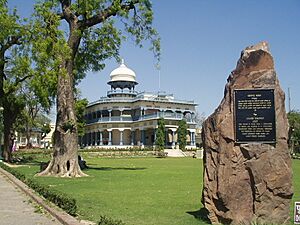
Prayagraj has a rich history of literature and art. It was once called Prayag in ancient Hindu texts. Chinese travelers like Faxian and Xuanzang found it a thriving city centuries ago. The city is known as the "literary capital of Uttar Pradesh."
In 1900, Saraswati, the first Hindi-language monthly magazine in India, started here. The Anand Bhavan, a home of the Nehru family, has many items from their history.
Many famous Hindi writers like Mahadevi Varma and Harivansh Rai Bachchan helped modernize Hindi literature here. Prayagraj is also a center for publishing Hindi books. Persian and Urdu literature are also important here. The city has produced noted Urdu poets like Akbar Allahabadi. The famous English author Rudyard Kipling also worked for a newspaper in Prayagraj.
Entertainment and Recreation
Prayagraj is a great place for historical, cultural, and religious tourism. Historical sites include Alfred Park, the Victoria and Thornhill Mayne Memorials, and Allahabad Fort. Religious places include the Kumbh Mela and the Triveni Sangam.
The city hosts the Maha Kumbh Mela, the world's largest religious gathering, every twelve years. It also hosts the Ardh (half) Kumbh Mela every six years, and a Magh Mela every year. Cultural spots include the Allahabad Museum and the Jawahar Planetarium. The North Central Zone Culture Centre and Prayag Sangeet Samiti are famous centers for arts, dance, music, and theater. The city has also hosted the International Film Festival of Prayag.
Media and News
The Leader and The Pioneer are two main English newspapers published in Prayagraj. All India Radio has radio stations here, and there are also seven FM radio stations. You can watch regional TV channels through cable or satellite.
Sports and Games
Cricket and field hockey are the most popular sports in Prayagraj. Other games like kabaddi and kho-kho are played more in rural areas. Gully cricket (street cricket) is very popular among young people in the city.
The famous Allahabad Cricketers club has produced many national and international players. There are several sports complexes, including the Madan Mohan Malviya Stadium and the Amitabh Bachchan Sports Complex. The National Sports Academy in Jhalwa trains gymnasts. The Indira Marathon is a running event held in honor of former Prime Minister Indira Gandhi.
Famous People from Prayagraj
See also
 In Spanish: Prayagraj para niños
In Spanish: Prayagraj para niños


